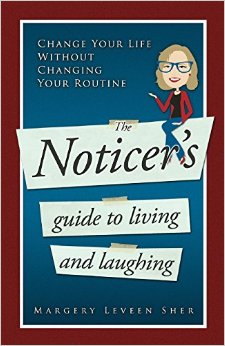I couldn’t open up The Noticer’s Guide to Living and Laughing, penned by Margery Leveen Sher, quickly enough. Not only did the cover page claim that the book could help “change your life without changing your routine,” but the back of the book posed such questions as: “Do you want to be awestruck every day? Do you want to laugh more?” Well, of course I did. Who doesn’t want to feel awestruck every day? And although I laugh quite a bit, there is always room for more. What was the secret to bettering my life without making drastic alterations? I was about to find out.
Right from the very beginning, the author acknowledges the fact that although money can’t buy happiness and there is more to life than money, it is still very important. I was happy she mentioned this because I feel as if I read so many books and articles out there that seem to be telling people they work too much, to take some time off, sit back and smell the roses when the reality of the matter is that some of us absolutely need to work a great deal in order to simply be financially stable, or (hopefully) comfortable. She then says that there is no necessary change required to our daily routines in order for our lives to change. Since this is what initially caught my attention as being so unique, I was eager to learn more.
The first page of the introduction admittedly made me a little doubtful, when Sher begins her description of the art of “noticing” things, only because I just do not feel as if I am the type of person to become elated at the sight of a broccoli stem or a jacket zipper. However, noticing seemed like it was a big deal to the author (I mean, it’s in the title of the book and pretty much what her entire concept of life-change revolves around) and I did want to hear her out, though, so I continued.
She separates the book into three categories of noticing things: amazing things to notice, annoying things to notice, and human “idiosyn-crazies” to notice. She begins with the “amazing” section. These are all those instances in life that are….well, amazing. Tiny miracles such as sunsets, events to celebrate (like birthdays), as well as incredible food, overlooked inventions, everything that exists in nature, and so on. By the end of that segment, even I, a self-proclaimed cynic, was starting to come around to the idea of perhaps noticing the world around me a little bit more. I even was given a history lesson about the number 60- who knew one number could have so much background? That is pretty…amazing.
The next group of noticings she describes are the “annoying things to notice.” I, personally, found this section very entertaining and fun to read, which probably speaks volumes about my nature. I couldn’t help it, though! As someone who works in customer service, and talks to people day in and day out, it was fun to read about all the annoying things they do. It felt as if I were kicking back with the author and venting (about annoyances from pharmaceutical commercials to self-flushing toilets), which is a delightful feeling to have while reading.
The “human idiosyn-crazies” part focuses on all the weird, seemingly crazy things we, as humans, do on a daily basis. For example, Sher poses the question, “When did we all begin to smile for cameras or for pictures?” and mentions that she has a weird habit of superstitiously spitting over her shoulder. She also encourages the readers to think about themselves, what strange “idiosyn-crazies” they have, and how it fits into their characters and who they are as people. It made me think about myself, and I acknowledged the fact that whenever I’m home alone and look in the mirror, I almost always have to make a horrifying face at myself. I guess I’m a weirdo just like everyone else.
Sher includes in every portion various conversation-starters regarding the topic she is talking about. For example, she will have little conversation-starters to use with little kids about the subject of miracles, or conversation-starters to use with your spouse or the whole family about the subject of listening. I found this to be a really awesome addition to the book, and genuinely helpful.
The author’s honest excitement and zest for life emanates from every single page, and it really is contagious. I couldn’t help but feel myself getting exhilarated by learning a little more about art, outer space, and physics. That unfamiliar exhilaration was a direct result of Sher’s spirited way of writing, which conveys her positivity, warmth, and love for almost everything. I particularly liked a page titled “Are You Bored,” which provides readers with a whole list of things to think about or look up if they are feeling bored, such as all the accomplishments of Leonardo Da Vinci or why the Leaning Tower of Pisa does not fall over. It is almost as if she is illustrating the fact that no time needs to be stagnant or without meaning; there is always something to do.
Reading this book really was like a breath of fresh air, and I’m so happy I didn’t allow my initial doubt (read: cynicism) to deter me from finishing it. I turned the final page with a smile on my face…something I made sure to notice.
Twisted Talk: Do you think you would find this book helpful? What’s are some of your ‘idiosyn-crazies?’ Discuss below!









